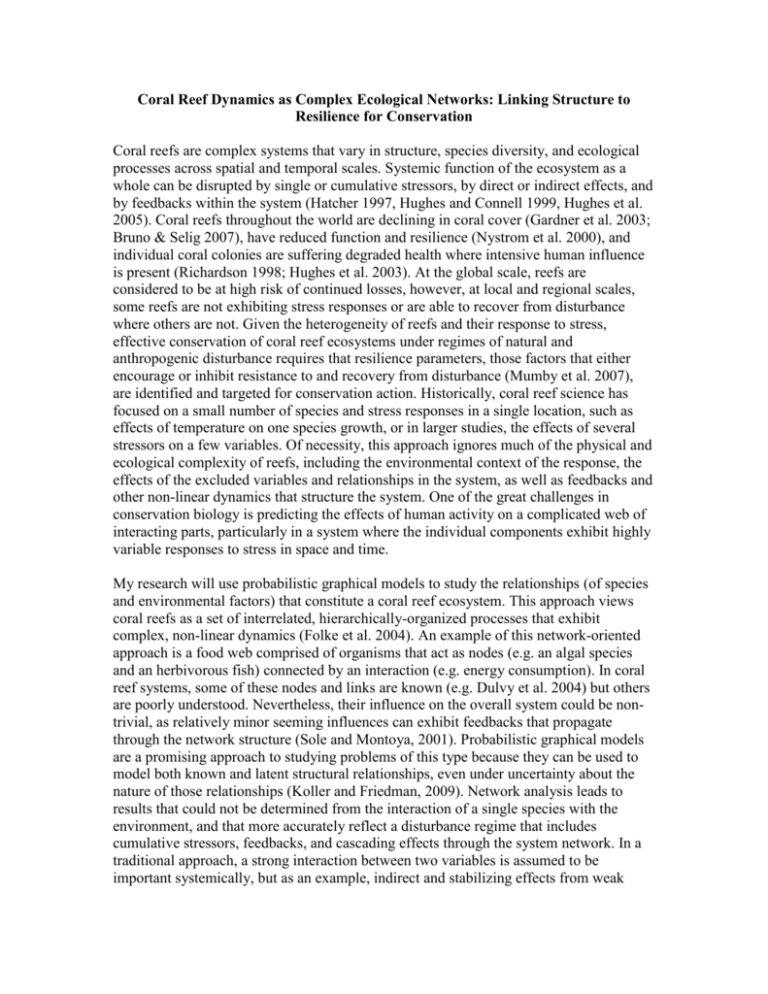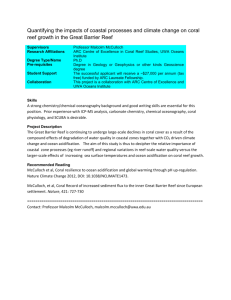proposal - shanee stopnitzky
advertisement

Coral Reef Dynamics as Complex Ecological Networks: Linking Structure to Resilience for Conservation Coral reefs are complex systems that vary in structure, species diversity, and ecological processes across spatial and temporal scales. Systemic function of the ecosystem as a whole can be disrupted by single or cumulative stressors, by direct or indirect effects, and by feedbacks within the system (Hatcher 1997, Hughes and Connell 1999, Hughes et al. 2005). Coral reefs throughout the world are declining in coral cover (Gardner et al. 2003; Bruno & Selig 2007), have reduced function and resilience (Nystrom et al. 2000), and individual coral colonies are suffering degraded health where intensive human influence is present (Richardson 1998; Hughes et al. 2003). At the global scale, reefs are considered to be at high risk of continued losses, however, at local and regional scales, some reefs are not exhibiting stress responses or are able to recover from disturbance where others are not. Given the heterogeneity of reefs and their response to stress, effective conservation of coral reef ecosystems under regimes of natural and anthropogenic disturbance requires that resilience parameters, those factors that either encourage or inhibit resistance to and recovery from disturbance (Mumby et al. 2007), are identified and targeted for conservation action. Historically, coral reef science has focused on a small number of species and stress responses in a single location, such as effects of temperature on one species growth, or in larger studies, the effects of several stressors on a few variables. Of necessity, this approach ignores much of the physical and ecological complexity of reefs, including the environmental context of the response, the effects of the excluded variables and relationships in the system, as well as feedbacks and other non-linear dynamics that structure the system. One of the great challenges in conservation biology is predicting the effects of human activity on a complicated web of interacting parts, particularly in a system where the individual components exhibit highly variable responses to stress in space and time. My research will use probabilistic graphical models to study the relationships (of species and environmental factors) that constitute a coral reef ecosystem. This approach views coral reefs as a set of interrelated, hierarchically-organized processes that exhibit complex, non-linear dynamics (Folke et al. 2004). An example of this network-oriented approach is a food web comprised of organisms that act as nodes (e.g. an algal species and an herbivorous fish) connected by an interaction (e.g. energy consumption). In coral reef systems, some of these nodes and links are known (e.g. Dulvy et al. 2004) but others are poorly understood. Nevertheless, their influence on the overall system could be nontrivial, as relatively minor seeming influences can exhibit feedbacks that propagate through the network structure (Sole and Montoya, 2001). Probabilistic graphical models are a promising approach to studying problems of this type because they can be used to model both known and latent structural relationships, even under uncertainty about the nature of those relationships (Koller and Friedman, 2009). Network analysis leads to results that could not be determined from the interaction of a single species with the environment, and that more accurately reflect a disturbance regime that includes cumulative stressors, feedbacks, and cascading effects through the system network. In a traditional approach, a strong interaction between two variables is assumed to be important systemically, but as an example, indirect and stabilizing effects from weak interactions can have a strong effect on system maintenance (Berlow 1999) that would go undetected by traditional analyses. These influential nodes and links may not be intuitively identified from their interaction strengths, but are most responsible for the maintenance of the network structure and function (Berlow et al. 2009), and are therefore critical indicators of resilience and the most important targets for management action. Strong examples of ecological networks in marine, terrestrial and economic systems have successfully predicted the whole ecosystem response to a changing environment (Williams and Martinez 2000), and these powerful methods have not yet been applied to system ecology of coral reefs. In my PhD research, I propose to investigate the following research questions using complex ecological network analysis: 1. Which interactions in a coral reef ecosystem have the greatest influence on maintaining its structure, function, and service provision? 2. Do influential interactions gain or lose influence at different spatial scales and if so, what types of interactions are influential at what scales? 3. How do interactions gain or lose influence on the whole system under different disturbance or stressor regimes? The final chapter of my PhD thesis will assess the potential for engaging recreational divers in scientific network analysis of coral reefs, which is described in greater detail below. To address these questions, I will develop a probabilistic niche model (Williams and Martinez 2000) of the linkage structure of each reef, and will include up to three interacting components that relate physical and chemical links in addition to biological. Model nodes are any variables that interact, including species and stressors. To develop a dynamical model of bioenergetics, I will determine interactions and their relative strengths from existing data and estimates that are derived from known relationships between organism size and metabolic requirements. These two component models will be hybridized to integrate the structural and dynamical properties of the reef. I will then analyze each network’s structural properties (e.g. density, size, path length, clustering, connectedness, etc.) and dynamical properties (e.g. stability, multistability, persistence, resilience, feedbacks, nonlinearity, etc.), and will perform probabilistic simulations given different scenarios. Ground-truthing and simulating future scenarios are performed in the model similarly by adding and removing structural elements, altering interaction strengths and then comparing the resulting network properties to each other and to realworld examples (Pascual and Dunne 2006). For my program collaboration with the Dr. Nancy Foster scholarship, I would like to address my research questions using the Florida Keys National Marine Sanctuary (FKNMS) as a study system. The FKNMS is uniquely suited to investigate these questions because: a. its relatively low ecosystem diversity allows for a simpler network structure, b. its islands vary in their proximity to and use by human populations for comparison of disturbance regimes, and c. because of the availability of long-term data. The large management effort in the area and different zones of extraction regulations also offer real-world examples to ground-truth the effects of altering reef network structure of reefs (e.g. fishing removes targeted fish from the network and alters interaction strengths with other species). Network analysis of the FKNMS will yield three scientific outcomes: 1. Identifying the factors that control ecosystem structure, which is critical knowledge for how best to conserve ecosystem function with limited resources, 2. Understanding variability in network properties between reefs, which is essential to estimating vulnerability to human impacts, and 3. Predicting the ecosystem response to specific disturbance regimes that are simulated in the network model, which allows managers to assess the sensitivity of a reef to natural or anthropogenic disturbance. The models and visualization tools produced from this study will be provided to resource managers working specifically in the FKNMS, and will be published online as a template that can be applied to all marine systems for identifying the most efficient conservation targets. In order to engage the public with my work, I am developing a citizen science training program that encourages recreational divers to participate in the scientific process. Recreational divers log more underwater observation hours in more locations than scientists can, are often highly engaged in the natural history of dive sites and have enormous potential for meaningful scientific collaboration. As an example, species interactions on reefs are poorly known in part due to limited observation time, and our ability to model reef dynamics will improve substantially with increased records of interactions. The benefit of these collaborations is three-fold: science benefits from more data and new ideas, divers are enriched by making valuable contributions to protecting their resources, and management efforts benefit from receiving better scientific information as well as deeper and broader engagement in conservation by resource stakeholders. In order to facilitate these collaborations, I have partnered with a software engineer and a website is currently under construction that will teach divers how to collect data, make observations and form hypotheses. The site will be open to all and will allow users to upload, crowd-analyze and visualize data that they collect, as well as provide a community forum where users can ask questions and discuss the project. I will implement a pilot version of this citizen science program at multiple dive shops in the Florida Keys in order to identify opportunities for improving public engagement, training curriculum and website functionality. Following this pilot, I will develop a model that has been improved by adding citizen observations to the network structure, and compare this to a previous network model in the same area so as to statistically estimate the potential information gain by citizen scientist participation. This study will be the first to use a complex network approach for coral reef ecological dynamics and will also be innovative within the field of complexity science by incorporating non-trophic interactions among network components. This research has the potential to substantially improve evidence-based coral reef conservation by deepening our understanding of the interdependence among reef components and by revealing the most influential mechanisms in the system, which will directly inform management action. Therefore, this project aligns perfectly with both my and NOAA’s missions to improve our knowledge and ability to predict complex ocean ecosystem dynamics, to share this knowledge openly, and to use it to conserve our valuable resources.






